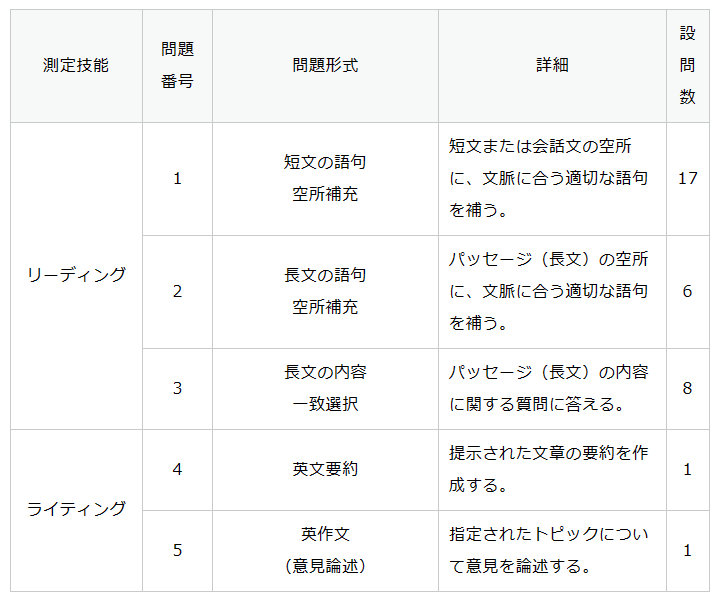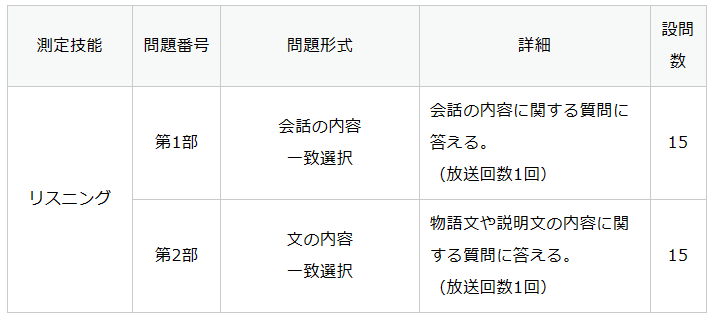
2024年度第1回から英検2級がリニューアルされます。以下、英検サイトより問題形式や設問数をチェックしてみましょう。
●筆記試験
●リスニングテスト
さて、この表を頭に入れ、さっそく英検2級の効果的な解き方や時間配分を考えていきましょう!!まずは、英検2級の各設問ごとの時間配分のポイントです。
【英検2級 新形式版の時間配分】
★ 全体の配分の目安:
– リーディング・ライティング (31問): 85分
– リスニング: 約25分
★ リーディング・ライティングの配分の目安:
– 短文の語句空所補充 (17問): 9分 (1問30秒)
– 長文の語句空所補充 (6問): 12分 (大問1つ6分)
– 長文の内容一致選択 (8問): 24分 (大問1つ12分)
– ライティング (2問): 35分 ※
– 見直し: 5分
– リスニングの先読み: 上記の目安で余った時間
※【新形式のライティング問題の時間配分】
英検2級の新形式では、ライティングの問題が従来の1題から2題に増えます。
1. 意見論述問題
– 従来からある問題形式で、指定されたトピックについて自分の意見を論理的に述べる必要があります。
– 推奨時間は20分程度です。
2. 要約問題
– 新たに追加された問題形式です。与えられた英文(約150語程度)を要約する必要があります。
– 推奨時間は15分程度と考えられています。
つまり、ライティング全体で35分程度が目安となります。意見論述20分、要約15分という時間配分が適切でしょう。
要約問題では、文章の主旨や重要ポイントを適切に捉え、簡潔に要約することが求められます。具体例は避け、抽象的な表現で要約する必要があります。
要約問題では以下の4点が評価されるため、時間内に的確な要約ができるよう練習が重要です。
① 内容 – 英文の要点を適切に捉えているか
② 構成 – 論理的に文章を構築できているか
③ 語彙・文法 – 適切な語彙・文法を用いているか
④ 表現 – 文の構造や語句の言い換えに工夫があるか
★ おすすめの解答順:
1) ライティング
2) 短文の語句空所補充
3) 長文の語句空所補充
4) 長文の内容一致選択
5) 見直し
★ 時間配分のコツ:
– わからない問題は飛ばして後で戻る
– ライティングは構成を最初に考え、数文書くごとに確認する
– リスニングの選択肢は先読みしておく
★ 時間内に解くための勉強法:
– 過去問で、セクションごとにかかった時間を計測、記録する。(学習タイマーを購入し、上の時間配分めやすにタイマーを合わせて解く)
– パス単を購入し、単語力を強化して問題を素早く理解できるようにする
英検2級では、ライティング問題に十分な時間を割き、内容と表現を意識して取り組む必要があります。新形式の要約問題にも対応できるよう、過去問や模擬問題を活用した練習が重要になります。
☆おすすめの学習タイマーはドリテックのラーニングタイマー!
T-587ラーニングタイマー – 株式会社ドリテック (dretec.co.jp)
試しに問題を解いてみよう!
リーディングの長文空所補充問題(予想問題)にチャレンジしてみましょう!英検2級の新しい形式では、大問2で2つの問題(合計6問)が出題されます。制限時間を6分に設定しましょう!
The Growing Problem of Ocean Plastic Pollution
Ocean plastic pollution has become a major environmental concern in recent years. It is estimated that millions of tons of plastic waste end up in the oceans every year, causing harm to marine life and ecosystems. Plastic debris can be found in every corner of the ocean, from the surface to the deepest trenches. Birds, fish, and other marine animals often mistake plastic for food, leading to injury, starvation, and even death. Microplastics, tiny fragments of plastic less than 5mm in size, are also a growing problem as they can easily enter the food chain and potentially impact human health.
To address this issue, governments, organizations, and individuals are taking action to reduce plastic waste and prevent it from entering the oceans. ( 1 ) bans or restrictions on single-use plastics, such as bags, straws, and cutlery. Companies are also developing more sustainable packaging solutions and investing in recycling infrastructure. Individuals can also play a role, such as organizing beach clean-ups and promoting the use of reusable items.
However, solving the ocean plastic problem will require a global effort and significant changes in the way we produce, consume, and dispose of plastic. Researchers are working on developing new materials that are more easily biodegradable or recyclable. Governments and businesses need to invest in waste management systems and infrastructure, particularly in developing countries where a large portion of plastic waste originates. Furthermore, individuals can make a difference by reducing their use of single-use plastics, properly disposing of waste, and supporting businesses that prioritize sustainability. ( 2 ) addressing ocean plastic pollution will require ( 3 ) to ensure a cleaner and healthier future for our oceans and planet.
(253 words)
(1)
1 Many countries have implemented
2 Many countries are considering implementing
3 Few countries have implemented
4 No countries have implemented
(2)
1 On the other hand
2 In contrast
3 Furthermore
4 In conclusion
(3)
1 the efforts of a single country
2 the cooperation of all stakeholders
3 the development of new technologies
4 the implementation of strict laws
【解答】
(1) 1
(2) 4
(3) 2
【解説】
(1) 多くの国が、レジ袋やストロー、カトラリーなどの使い捨てプラスチックに対する禁止や制限を実施していると述べられているため、1が正解です。
(2) 文章の最後に、海洋プラスチック問題への取り組みには多面的なアプローチと関係者の協力が必要であると結論づけているため、4の “In conclusion” が最も適しています。
(3) 海洋プラスチック問題の解決には、すべての関係者の協力が必要であると述べられているため、2が正解です。
【音読用スクリプト】
The Growing Problem of Ocean Plastic Pollution
Ocean plastic pollution has become a major environmental concern in recent years. It is estimated that millions of tons of plastic waste end up in the oceans every year, causing harm to marine life and ecosystems. Plastic debris can be found in every corner of the ocean, from the surface to the deepest trenches. Birds, fish, and other marine animals often mistake plastic for food, leading to injury, starvation, and even death. Microplastics, tiny fragments of plastic less than 5mm in size, are also a growing problem as they can easily enter the food chain and potentially impact human health.
To address this issue, governments, organizations, and individuals are taking action to reduce plastic waste and prevent it from entering the oceans. Many countries have implemented bans or restrictions on single-use plastics, such as bags, straws, and cutlery. Companies are also developing more sustainable packaging solutions and investing in recycling infrastructure. Individuals can also play a role, such as organizing beach clean-ups and promoting the use of reusable items.
However, solving the ocean plastic problem will require a global effort and significant changes in the way we produce, consume, and dispose of plastic. Researchers are working on developing new materials that are more easily biodegradable or recyclable. Governments and businesses need to invest in waste management systems and infrastructure, particularly in developing countries where a large portion of plastic waste originates. Furthermore, individuals can make a difference by reducing their use of single-use plastics, properly disposing of waste, and supporting businesses that prioritize sustainability. In conclusion, addressing ocean plastic pollution will require the cooperation of all stakeholders to ensure a cleaner and healthier future for our oceans and planet.
【訳】
海洋プラスチック汚染の深刻化
近年、海洋プラスチック汚染は大きな環境問題となっています。毎年数百万トンものプラスチックごみが海洋に流出し、海洋生物や生態系に悪影響を及ぼしていると推定されています。プラスチックの破片は、海面から最深部の海溝まで、海のあらゆる場所で見つかります。鳥や魚などの海洋生物は、プラスチックを餌と間違えて食べてしまうことがあり、怪我や飢餓、さらには死に至ることもあります。また、5mm以下の微小なプラスチック片であるマイクロプラスチックも深刻な問題となっており、食物連鎖に容易に入り込み、人の健康にも潜在的な影響を与える可能性があります。
この問題に対処するため、政府、組織、個人がプラスチックごみを削減し、海洋への流出を防ぐための行動を取っています。多くの国では、レジ袋やストロー、カトラリーなどの使い捨てプラスチックの禁止や規制を実施しています。企業も、より持続可能な包装ソリューションの開発やリサイクルインフラへの投資を行っています。個人も、ビーチクリーンアップの開催や再利用可能なアイテムの使用促進など、役割を果たすことができます。
しかし、海洋プラスチック問題を解決するには、プラスチックの生産、消費、廃棄の方法を大きく変革する必要があり、世界的な取り組みが求められます。研究者は、より生分解性が高く、リサイクルしやすい新素材の開発に取り組んでいます。政府と企業は、特にプラスチックごみの大部分が発生している発展途上国において、廃棄物管理システムとインフラへの投資を行う必要があります。さらに、個人は使い捨てプラスチックの使用を減らし、適切に廃棄物を処理し、持続可能性を重視する企業を支援することで、変化を起こすことができます。結論として、海洋プラスチック汚染に取り組むには、海洋と地球のより清潔で健康的な未来を確保するために、すべての関係者の協力が不可欠です。

